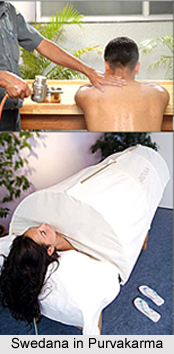 Swedana in Purvakarma is defined as the second major aspect of the preparatory procedures. In Ayurveda, it is called as the therapeutic application of heat to the body. Swedana literally means `sweat`. However, the main objective of swedana is not to produce sweat but to dilate the body`s shrotas or channels so that the objective of oleation that is of removing aama from the dhatus, can be reached readily. It is said that sweat results naturally when the channels of the body widen. Additionally, the application of heat also counteracts the coldness of both vata and kapha reducing the heaviness ands stiffness of the body and countering the slow, sticky and heavy attributes of aama.
Swedana in Purvakarma is defined as the second major aspect of the preparatory procedures. In Ayurveda, it is called as the therapeutic application of heat to the body. Swedana literally means `sweat`. However, the main objective of swedana is not to produce sweat but to dilate the body`s shrotas or channels so that the objective of oleation that is of removing aama from the dhatus, can be reached readily. It is said that sweat results naturally when the channels of the body widen. Additionally, the application of heat also counteracts the coldness of both vata and kapha reducing the heaviness ands stiffness of the body and countering the slow, sticky and heavy attributes of aama.
The heating action of swedana helps in mobilizing the doshas that are responsible for transporting the waste toxic waste materials from the deep tissues to the gastrointestinal tract. As the influence of agni bhuta increases, it starts to soften the density of aama making it easier to be carried from the tissues. Moreover, swedana also produces tissue expansion that also facilitates aama`s release. Dilating the body`s internal channels creates a pathway for the elimination of the waste products and toxins from the body. When aama leaves the body, stiffness and rigidity in the dhatus is reduced, providing the body more suppleness and flexibility.
Types of Swedana used in Purvakarma
Ayurveda mentions that several types of swedana exist. But there are two major and primary forms used during the preparatory procedures of Pancha Karma and these are nadi swedana and bashpa swedana. The two primary types of swedana therapy are briefly mentioned below -
Nadi Swedana
It also means penetrating heat. Nadi literally means tube that uses steam from an herbal water decoction. Nadi is a more penetrating type of wet heat than bashpa, because the steam actively drives the heat and oil deep into the tissues through the pores of the skin. This type of steam treatment is given to the whole body and it focuses on the thick and complex structures of the joints seven minutes. Outside the Pancha Karma process, it can be used with snehana for reducing pain, muscle spasm and rigidity in localized areas. Nadi swedana treatment can be very helpful in the palliative management of backache, inflammation of the spine, knee and for generalized muscle pain.
Bashpa Swedana
Bashpa swedana also means steam bath. This type of agni swedana generally follows immediately after nadi swedana is administered. Bashpa literally means `steam`. Unlike the more directed form of heat that is used in nadi swedana, this particular application applies steam evenly to the entire body. In this therapy, a sweat box is used in which the patient either sits or lies down on his back. Every part of the body is exposed to the steam except the head as it cannot tolerate high temperatures. Moreover, a technician continuously places cool compresses on the forehead during the entire treatment to maintain the normal temperature of the head. In order to avoid dehydration, a glass of water is given to the patient.
The signs of effective and complete swedana involve sweat and warmth in the body with no stiffness or chill. After this treatment, the patient feels more enthusiastic and light. Bashpa swedana is an important preparatory procedure. However, it is not appropriate for people with heart disease and hypertension. Nadi swedana is used for individuals with blood disorders and those who cannot tolerate high temperatures. Its penetrating heat is comparatively milder and has a localized effect.
Swedana along with snehana are termed as essential procedures to the five main eliminative treatments used in Pancha Karma. The heating effects of swedana are used to dilate the body`s channels, mobilize the doshas and facilitate aama`s extraction and transport back to the gastrointestinal tract. Without the help of this procedure, toxins would not be available for complete disposal.





